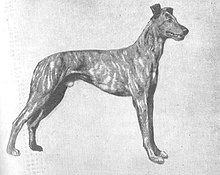1941 UK & Ireland Greyhound Racing Year
| 1941 UK & Ireland Greyhound Racing Year | |
|---|---|
 Ballynennan Moon, the leading greyhound during the war | |
The 1941 UK & Ireland Greyhound Racing Year was the 16th year of greyhound racing in the United Kingdom and Ireland.[1]
Summary
The year was dominated by the effects of World War II. The remaining classic races that had not been suspended in 1940 were duly suspended in 1941, with the exception of the Irish Greyhound Derby and Scottish Greyhound Derby.[2][3][4]
Racing did continue at many venues but was restricted to afternoons during the winter, this is because of the blackout regulations and during the summer the meetings were held in the early part of the evening. Matinee meetings would also take place on weekends at some tracks. Staffing the racing worsened as many of the stadium and kennel staff were called up to serve.[2][3][4]
Remarkably, despite restrictions on racing then annual totalisator turnover set a new record, reaching £42,027,642 and with a tax of 6% was a significant income for the government.[5]
on 22 September, leading trainer Joe Harmon died, leaving a huge gap to fill in the trainers ranks.[6]
Competitions
Shortly before his death, trainer Joe Harmon continued his successful run of big race wins by training Lights O'London, who won the Scottish Derby.[7] Ballycurreen Soldier reached his third consecutive Scottish Derby final under the training of a third different trainer. The event was completed in one evening, with heats at 7:35 pm and 7:55 pm and the final later at 9:45 pm.[8][9] The principal London races remaining on the open race calendar were The Cambridgeshire, Wimbledon Spring Cup, Wimbledon Gold Cup, Wembley Gold Cup and Two Year Old Produce Stakes, also at Wimbledon.[2][3][4]
Ballynennan Moon, now with Sidney Orton and owned by mrs Cearns, won the Wembley Summer Cup in August,[10] quickly followed by the Berkeley Cup and was beginning to come to prominence as the nation's leading greyhound. However, with no English Greyhound Derby taking place, this brindle dog would never have the opportunity to claim the sport's biggest prize.[11]
Ireland
Iris racing suffered from the dreaded Foot-and-mouth disease; traveling almost ceased and the Irish tracks came to a standstill in many areas. The ban was finally lifted at the end of the summer and hectic plans were drawn up to save the Irish Derby before the year ended. This resulted in a late October slot for the competition and would be run at Shelbourne Park because Cork Greyhound Stadium had ruled themselves out from being able to stage the race. Harold's Cross Stadium also managed to stage the Grand National at late notice, which went down well with the Irish Coursing Club, who had noted that both Dublin tracks had come to the rescue. The Grand National title went to The Gunner.[2][3][4][12] The Irish Greyhound Derby winner Brave Damsel, owned by John Byrne and The Gunner, were both sold to England. The latter was bought by a syndicate in Oxford for the sum of £400 and would become a crowd favourite at the recently built Oxford Stadium because of his hurdling ability.[13]
Roll of honour
| Major Winners | |
|---|---|
| Award | Name of Winner |
| 1941 English Greyhound Derby | Suspended |
| 1941 Irish Greyhound Derby[13] | Brave Damsel |
| 1941 Scottish Greyhound Derby[14] | Lights O'London |
| 1941 Welsh Greyhound Derby | Suspended |
|
| ||||||||||||||||||||||||||||||||||||||||||||||||
Tracks opened
| Date | Stadium/Track | Location | Ref |
|---|---|---|---|
| 22 March | Doncaster Greyhound Stadium | Doncaster | [15] |
Totalisator Returns
References
- ^ Fry, Paul (1995). The Official NGRC Greyhound Racing Yearbook. Ringpress Books. ISBN 186054-010-4.
- ^ a b c d Genders, Roy (1975). The Greyhound and Racing Greyhound. Page Brothers (Norwich). ISBN 0-85020-0474.
- ^ a b c d Genders, Roy (1981). The Encyclopedia of Greyhound Racing. Pelham Books Ltd. ISBN 07207-1106-1.
- ^ a b c d Genders, Roy (1990). NGRC book of Greyhound Racing. Pelham Books Ltd. ISBN 0-7207-1804-X.
- ^ a b Particulars of Licensed tracks, table 1 Licensed Dog Racecourses. Licensing Authorities. 1941.
- ^ "Joe Harmon". Daily Herald. 23 September 1941. Retrieved 8 December 2024 – via British Newspaper Archive.
- ^ "Greyhound News". Acton Gazette. 8 August 1941. Retrieved 7 December 2024 – via British Newspaper Archive.
- ^ "Thrill Finish". Daily Record. 19 July 1941. Retrieved 8 December 2024 – via British Newspaper Archive.
- ^ "Remember When - July". Greyhound Star. 15 July 2018.
- ^ "Mrs. Cearns' Cup Winner - Ballynennan Moon". Norwood News. 15 August 1941. Retrieved 7 December 2024 – via British Newspaper Archive.
- ^ "Hall of Fame, Ballynennan Moon". Greyhound Board of Great Britain.
- ^ Barnes, Julia (1988). Daily Mirror Greyhound Fact File. Ringpress Books. ISBN 0-948955-15-5.
- ^ a b Comyn, John. 50 Years of Greyhound Racing in Ireland. Aherlow Publishers Ltd.
- ^ Hobbs, Jonathan (2007). Greyhound Annual 2008, pages 153-154. Raceform. ISBN 978-1-905153-53-4.
- ^ "Doncaster Greyhound Stadium". Yorkshire Evening Post. 31 March 1941. Retrieved 7 December 2024 – via British Newspaper Archive.
